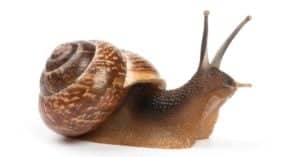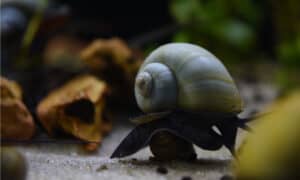Snails are interesting animals, even if they are found to be gross and slimy by some people . Besides their shells, one of the most notable features of snails is their spindly little eyes that sit atop their heads. They are so alien to their human equivalent in appearance, but do they actually work like a human eye? Let’s take a look at snail eyes and learn everything about them that we can!
Do snails have eyes?

Snails have vesicular eyes that can see blurry and unfocused pictures.
©Bildagentur Zoonar GmbH/Shutterstock.com
In short, yes, snails have eyes that sit on top of their heads on two small stalks. Snails may have eyes, but they are designed differently than a human eye. Additionally, the type of snail that you are talking about will determine the type (and placement) of eyes that they have.
Land snails are the most famous and have the classic eyes on top of stalks that many are familiar with. They can move their stalks around to see things better and use their eyes to navigate their surroundings and look for food.
Sea snails also have eyes, but they aren’t like the land snails. Instead of having two stalks (tentacle-looking structures) on their heads, they have eyes placed on the base of their bodies. As a result, they can’t rotate or move their eyes when trying to see something, thus making their vision comparatively poorer than a land snail.
Additionally, there are snails on earth that can’t see due to a lack of eyes. Many underground snails often don’t have eyes and wouldn’t use them even if they did. As a result, they have developed different senses to navigate their environment.
So, as an answer to the question: most snails have eyes, but it mostly depends on the individual species.
Can snails see like a human?
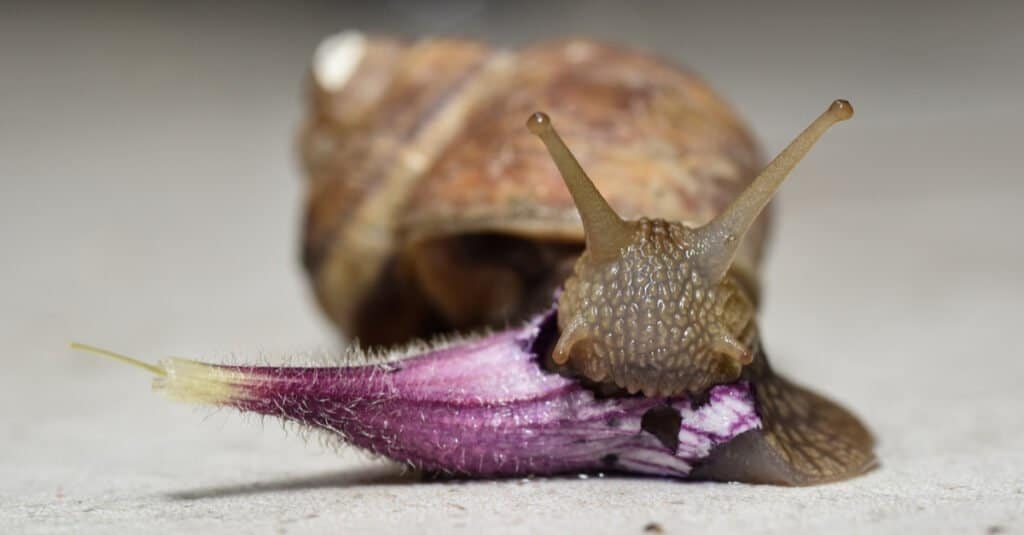
Snails can see, but a human has significantly better eyesight.
©microcosmos/Shutterstock.com
Not all eyes are created equal. On earth, there are all sorts of different evolutionary paths that have given vision to the creatures of the world. Some of the most common eye types are compound eyes, simple eyes, and camera-type eyes. Compound eyes are what you would normally see on a fly buzzing around your house. They have incredibly wide viewing angles and the ability to detect fast movement, but poor resolution. Simple eyes aren’t always simple, and the name refers to their use of a single lens (whereas the compound eye has multiple, all arranged together). A camera-type eye (like that of a human or a giant squid) takes in light and focuses it through a lens, projecting it onto a field. It often gives high resolution but has fairly limited viewing angles.
When it comes to a snail’s vision, things get complicated. Their ability to detect and see things mostly depends on the species. Generally, snails have a vesicular eye, which is something unique to mollusks and has quite an interesting evolutionary history. Snails have no ciliar muscles in their eyes (the muscle that allows us to reflexively focus images), thus requiring them to use their stalks to manually focus the images.
This adaptation gives snails better sight than many other invertebrates on earth. Still, when compared to a human, a snail’s vision simply doesn’t compare. In terms of resolution and picture quality, a human has far superior vision. Still, snails can probably see better than most other things that can be found in a garden!
Why are snail eyes on stalks?
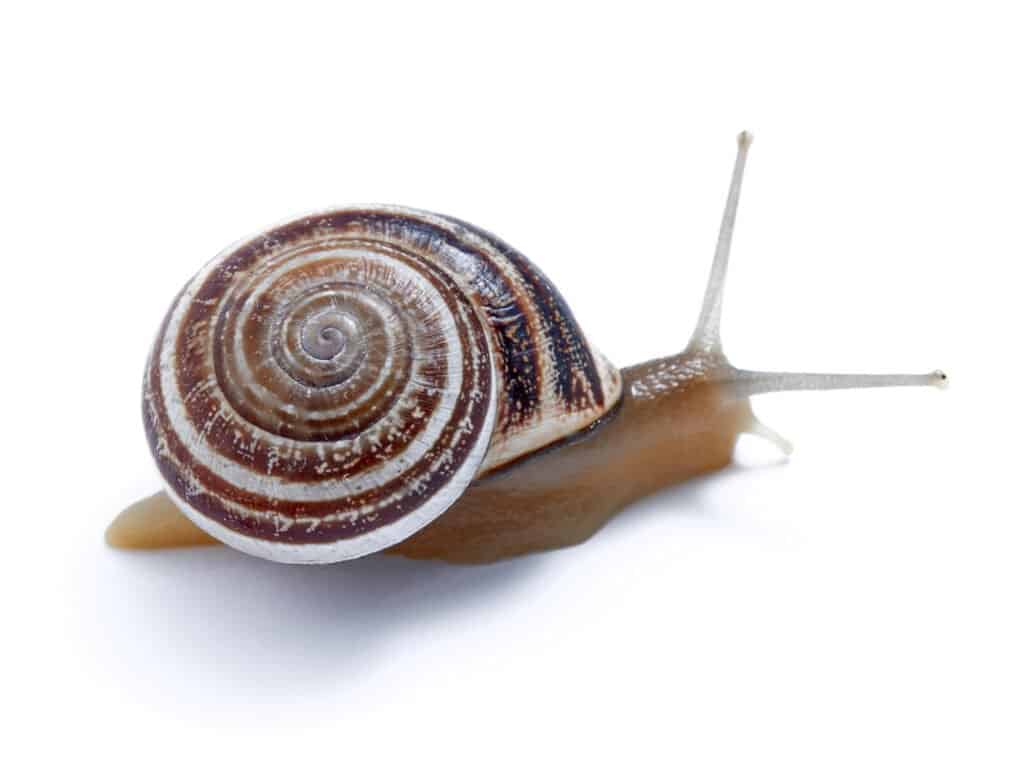
Snails have tentacles with sensory organs at the ends of them.
©Macronatura.es/Shutterstock.com
Land snails have their eyes on stalks for a few reasons. The first reason is that it allows them to focus their eyes manually. In a human eye, there is a little muscle that allows us to automatically focus the picture in front of us, depending on light and distance. A snail doesn’t have the same level of complexity in their eyes, meaning they need a different method of focusing their eyes. Their solution is to use their eyes stalks to manually focus the picture by moving it physically back and forth.
Additionally, the stalks allow a snail to look around without turning its body. If we wanted to look to the side or behind them, it would require us to move our entire head or body. For a snail, it’s much easier!
When it comes to sea snails, there are a few species that have their eyes on stalks. Since many of them have a mucous-like film that acts as a focusing agent, their stalks are mostly used to look out from their shells when they are hiding.
Can snails retract their eyes?
Many land snails have the ability to retract their eyes. The main reason for this is to keep them protected! It’s similar to our ability to blink or close our eyes when we need to. If something is going to hurt your eyes, it’s better to get them protected and secure. For snails, eyesight helps them find food, making them pretty important to protect.
What other senses do snails have?
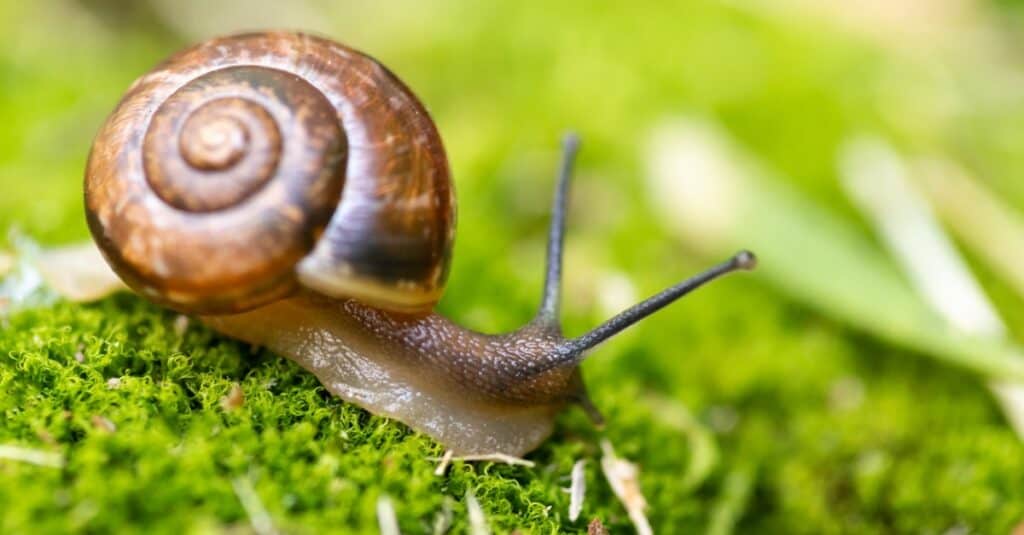
A snail can see, smell, taste, and sense vibrations.
©iStock.com/BushAlex
Aside from eyesight, snails have other senses that help them thrive in their specific ecological niches.
The primary sense they use is smell, even though they can see pictures. There are usually four tentacles on a snail’s head, two with eyes on the end and two near the front of their head. The two shorter ones are their smelling organs. These organs are used to smell and taste, making them perfect for finding food and determining if something is edible or not.
Additionally, snails have a sense of touch. This is easily seen by touching a snail and seeing them respond to that stimulus. Their sense of touch includes the ability to sense humidity, temperature, and more. Special cells distributed across their skin send signals that accumulate into their sense of touch.
While snails don’t have ears, they have the ability to feel vibrations.
The photo featured at the top of this post is © Dcschmidt - Public Domain
Thank you for reading! Have some feedback for us? Contact the AZ Animals editorial team.



